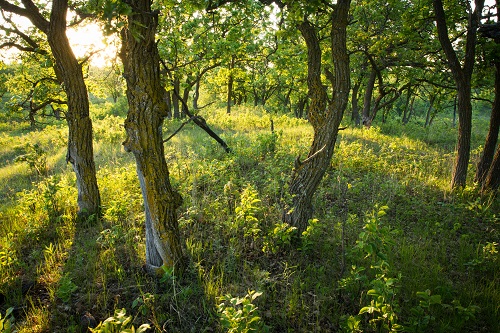Tall Grasses and Shrubs Dominate the Ground Layer of This Community under a Scattering of Trees.
What Makes an Oak Savanna Unique?

Oak savanna plant communities are characterized by bur oak trees with an understory of prairie grasses and forbs (wildflowers). Unlike in an oak woodland, the trees here are spaced out far enough for sun-loving prairie plants to still grow. Tall prairie grasses dominate the understory, including big bluestem, Indiangrass, and Canada wild rye. Forbs are an important component of the plant community, covering 5-50% of the ground. Common forbs such as heart-leaved alexanders, purple prairie clover, and goldenrods add a splash of color, as well as food for pollinators.
The frequency and intensity of fire, along with other factors, affect the ability of trees to become established in the landscape. Oak savannas exist naturally where fire occurs often enough to prevent trees from dominating the landscape, but are not so frequent or intense that trees cannot survive. Historically, this ecosystem only occurred where there was a barrier to slow down prairie fires such as water or topography, thus allowing scattered, small oaks to become established. More frequent fires would push this plant community to a tallgrass prairie ecosystem, nearly eliminating the tree canopy altogether. Fewer fires would transition the same site to a more heavily-treed oak woodland or shady oak forest.
At the time of settlement, oak savannas covered about 50 million acres in the Midwest. Most oak savannas have been converted into cropland, leaving only about 30,000 acres remaining, or only 0.06 percent of the original land area. Unfortunately, most of the remaining oak savanna is severely degraded due to invasive species and a lack of land management.

Fun fact:
Bur oaks have adaptations that allow them to thrive in fire-dependent plant communities such as oak savannas. How? Bur oaks have thick bark that insulates the cambium from the high temperatures produced by fires. The cambium is located just under the bark and is the growth layer of the tree. If the cambium is damaged, the tree is unable to add new cells and will die. Young trees are more susceptible to intense fires since they have not yet produced the thick bark of adult trees. Once bur oaks reach 12 to 15 years old, they are rarely damaged by fire and are quite resilient.
